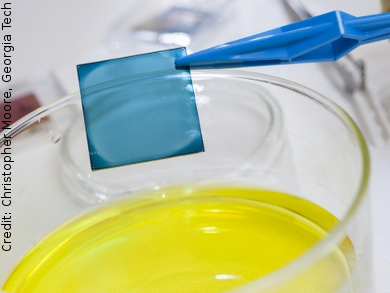Bernard Kippelen, Georgia Institute of Technology, Atlanta, USA, and colleagues have developed a technique for manufacturing single-layer organic polymer solar cells. The researchers use a solution-based approach for electrical p-doping of organic semiconductor films at room temperature. Thin films of organic semiconductors and their blends are immersed in polyoxometalate solutions (phosphomolybdic acid, PMA) in nitromethane.
The resulting geometry is unique. The functions of hole and electron collection are built into the light-absorbing active layer. This results in a simple, single-layer structure with few interfaces. The PMA-doped films show increased electrical conductivity and work function, reduced solubility in the processing solvent, and improved photo-oxidative stability in air (conversion efficiencies up to 5.9 ± 0.2 %; stable performance in shelf-lifetime studies at 60 °C for at least 280 h).
According to the scientists, their finding could move organic photovoltaics into a new generation of wearable devices and enable small-scale distributed power generation. High-performing organic solar cells require a multiple layer device structure. Single-layer photovoltaics will simplify the device fabrication process and therefore should reduce the cost. The technique has the potential to affect many device platforms, including organic printed electronics, sensors, photodetectors and light-emitting diodes.
- Solution-based electrical doping of semiconducting polymer films over a limited depth,
Vladimir A. Kolesov, Canek Fuentes-Hernandez, Wen-Fang Chou, Naoya Aizawa, Felipe A. Larrain, Ming Wang, Alberto Perrotta, Sangmoo Choi, Samuel Graham, Guillermo C. Bazan, Thuc-Quyen Nguyen, Seth R. Marder, Bernard Kippelen,
Nat. Mater. 2016.
DOI: 10.1038/nmat4818




